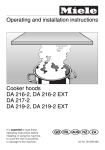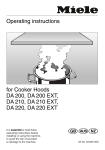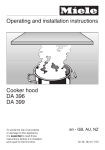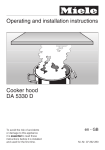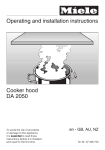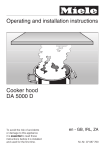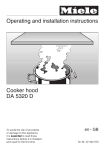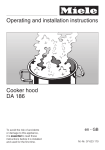Download Miele DA 210 Operating instructions
Transcript
Operating and installation instructions Cooker hoods DA 200-2, DA 200-2 EXT, DA 210-2, DA 210-2 EXT, DA 220-2, DA 220-2 EXT It is essential to read these operating instructions before installing or using the machine, to avoid the risk of accidents or damage to the machine. GiWOZr M.-Nr. 05 814 390 Contents Caring for the environment . . . . . . . . . . . . . . . . . . . . . . . . . . . . . . . . . . . . . . . . . . 3 Warning and Safety instructions . . . . . . . . . . . . . . . . . . . . . . . . . . . . . . . . . . . . . 4 Description of the appliance DA 200-2, DA 200-2 EXT . . . . . . . . . . . . . . . . . . . . . . . . . . . . . . . . . . . . . . . . . . . . . 8 DA 210-2, DA 210-2 EXT . . . . . . . . . . . . . . . . . . . . . . . . . . . . . . . . . . . . . . . . . . . . . 9 DA 220-2, DA 220-2 EXT . . . . . . . . . . . . . . . . . . . . . . . . . . . . . . . . . . . . . . . . . . . . 10 Brief description . . . . . . . . . . . . . . . . . . . . . . . . . . . . . . . . . . . . . . . . . . . . . . . . . 12 Operation Main switch . . . . . . . . . . . . . . . . . . . . . . . . . . . . . . . . . . . . . . . . . . . . . . . . . . . . . . 13 To switch the fan on . . . . . . . . . . . . . . . . . . . . . . . . . . . . . . . . . . . . . . . . . . . . . . . . 13 Selecting the power level. . . . . . . . . . . . . . . . . . . . . . . . . . . . . . . . . . . . . . . . . . . . 13 Run-on option . . . . . . . . . . . . . . . . . . . . . . . . . . . . . . . . . . . . . . . . . . . . . . . . . . . . 13 To switch the fan off . . . . . . . . . . . . . . . . . . . . . . . . . . . . . . . . . . . . . . . . . . . . . . . . 14 Switching the lighting on . . . . . . . . . . . . . . . . . . . . . . . . . . . . . . . . . . . . . . . . . . . . 14 To dim the lighting . . . . . . . . . . . . . . . . . . . . . . . . . . . . . . . . . . . . . . . . . . . . . . . . . 14 To switch the lighting off. . . . . . . . . . . . . . . . . . . . . . . . . . . . . . . . . . . . . . . . . . . . . 14 Filter operating hours counter . . . . . . . . . . . . . . . . . . . . . . . . . . . . . . . . . . . . . . . . 15 Reading the filter operating hours counter . . . . . . . . . . . . . . . . . . . . . . . . . . . . 15 Altering the filter operating hours counter . . . . . . . . . . . . . . . . . . . . . . . . . . . . 16 Cleaning and care Housing . . . . . . . . . . . . . . . . . . . . . . . . . . . . . . . . . . . . . . . . . . . . . . . . . . . . . . . . . 17 Grease filters . . . . . . . . . . . . . . . . . . . . . . . . . . . . . . . . . . . . . . . . . . . . . . . . . . . . . 18 Changing a halogen lamp . . . . . . . . . . . . . . . . . . . . . . . . . . . . . . . . . . . . . . . . . . . 20 After sales service . . . . . . . . . . . . . . . . . . . . . . . . . . . . . . . . . . . . . . . . . . . . . . . . 21 Appliance dimensions DA 200-2, DA 200-2 EXT . . . . . . . . . . . . . . . . . . . . . . . . . . . . . . . . . . . . . . . . . . . . 22 DA 210-2, DA 210-2 EXT . . . . . . . . . . . . . . . . . . . . . . . . . . . . . . . . . . . . . . . . . . . . 23 DA 220-2, DA 220-2 EXT . . . . . . . . . . . . . . . . . . . . . . . . . . . . . . . . . . . . . . . . . . . . 24 Installation . . . . . . . . . . . . . . . . . . . . . . . . . . . . . . . . . . . . . . . . . . . . . . . . . . . . . . 25 Connection for air extraction . . . . . . . . . . . . . . . . . . . . . . . . . . . . . . . . . . . . . . . 30 Condensate trap . . . . . . . . . . . . . . . . . . . . . . . . . . . . . . . . . . . . . . . . . . . . . . . . 31 Electrical connection . . . . . . . . . . . . . . . . . . . . . . . . . . . . . . . . . . . . . . . . . . . . . 32 Technical data . . . . . . . . . . . . . . . . . . . . . . . . . . . . . . . . . . . . . . . . . . . . . . . . . . . 33 2 Caring for the environment Disposal of the packing material Disposal of your old appliance The transport and protective packing has been selected from materials which are environmentally friendly for disposal and can normally be recycled. Old appliances contain materials which can be reclaimed or recycled. Please contact your dealer, your local waste collection centre or scrap merchant about potential recycling schemes. Ensure that any plastic wrappings, bags etc. are disposed safely and kept out of the reach of babies and young children. Danger of suffocation! Rather than just throwing these materials away, please ensure that they are recycled. Ensure that the appliance presents no danger to children while being stored for disposal. See the appropriate section in the Warning and safety instructions. 3 Warning and Safety instructions Technical safety This appliance conforms to current safety requirements. Incorrect use can however lead to personal injury and damage to the appliance. Before installation and before using for the fist time, read the operating instructions carefully. They contain important information on safety, installation, use and maintenance of the appliance. This way you will avoid the risk of accidents and damage to the appliance. Keep these operating instructions in a safe place and pass them on to any future user. Correct usage The appliance is intended for domestic use only. The manufacturer cannot be held liable for damage caused by improper or incorrect use of the appliance. Before connecting the appliance to the mains supply, make sure that the voltage and frequency details given on the data plate correspond with the on-site electricity supply, otherwise the appliance could be damaged. Consult a qualified electrician if in doubt. The electrical safety of this appliance can only be guaranteed when continuity is complete between the appliance and an effective earthing system which complies with local and national regulations. It is most important that this basic safety requirement is tested by a qualified electrician. The manufacturer cannot be held liable for the consequences of an inadequate earthing system (e.g. electric shock). Installation work and repairs may only be carried out by suitably qualified and competent persons to ensure safety. Repairs and other work by unqualified persons could be dangerous and the manufacturer will not be held liable. This equipment is not designed for maritime use or for use in mobile installations such as caravans, aircraft etc. However it may be suitable for such usage subject to a risk assessment of the installation being carried out by a suitably qualified engineer. 4 Warning and Safety instructions The appliance is only completely isolated from the electricity supply when: – it is switched off at the wall socket and the plug removed (do not pull on the cable, only on the plug), or – the fuse from the fused spur connection unit is withdrawn, or – the mains fuse is withdrawn, or – the screw-out fuse is removed in countries where this is applicable. Ensure power is not supplied to the appliance while maintenance or repair work is being carried out. Do not connect the appliance to the mains electricity supply by an extension lead. Extension leads do not guarantee the required safety of the appliance (e.g. danger of overheating). Use Do not let small children play with the appliance or its controls or operate it. Supervise its use by the elderly or infirm. Never use an open flame beneath the cooker hood. To avoid the danger of fire, do not flambé or grill under the cooker hood. When switched on, the cooker hood could draw flames into the filter. Fat particles drawn into the cooker hood present a fire hazard. When using the cooker hood over a gas hob ensure that any burners in use are always covered by a pan, otherwise flames could be drawn up by the suction of the cooker hood, parts of which could then be damaged. Always switch the cooker hood on when using the hob, otherwise condensation may collect in the hood, which could cause corrosion. When cooking with oil or fat, chip pans and deep fat fryers etc, do not leave the pans unattended. Never leave an open grill unattended when grilling. Overheated oil and fat can ignite and could set the cooker hood on fire. Do not use the cooker hood without the grease filters in place. This way you will avoid the risk of grease and dirt getting into the appliance and hindering its smooth operation. The filters should be regularly cleaned, or changed, as appropriate. Saturated filters are a fire hazard (see "Cleaning and care"). Under no circumstances use a steam-cleaning appliance to clean this appliance. Pressurised steam could reach the electrical components and cause a short circuit. In countries where there are areas which may be subject to infestation by cockroaches and other vermin, pay particular attention to keeping the appliance and its surroundings in a clean condition at all times. Any damage which may be caused by cockroaches or other vermin will not be covered by the appliance guarantee. 5 Warning and Safety instructions Installation The minimum safety distance between the top of the cooker / hob and the bottom of the cooker hood should be at least: – 550 mm above electric hobs and cookers, – 650 mm above gas hobs and cookers, – 650 mm above an open grill from our range For non-Miele cooking appliances maintain the safety distance as recommended by the manufacturer in their Installation and Operating instructions. If more than one appliance is fitted beneath the cooker hood and they have different minimum safety distances to the cooker hood, select the greater distance. Safety regulations prohibit the fitting of a cooker hood over solid fuel stoves. All ducting, pipework and fittings must be of non-flammable material. These can be obtained from the Miele Spare Parts department or from builders’ merchants. The appliance must not be connected to a chimney or vent flue which is in use. Neither should it be connected to ducting which ventilates rooms with fireplaces. If exhaust air is to be extracted into a chimney or ventilation duct no longer used for other purposes, seek professional advice. 6 Warning and Safety instructions When using the cooker hood at the same time as another heating appliance which depends on the air in the room (e.g. gas, oil or coal fired heaters, continuous flow or other water heaters, gas cooker, gas hob or gas oven), special care must be taken as the action of the cooker hood extracts air from the room, which these type of heaters need for combustion. They could also draw exhaust air back in from chimneys or ducting in contravention of fire safety regulations. In order to ensure safe operation, and to prevent gases given off by the heating appliances from being drawn back into the room when the extractor and the heater are in operation simultaneously, an underpressure in the room of 0.04 mbar (4 pa) is the maximum permissible. Ventilation can be maintained by air inlets which cannot be blocked, in windows, doors and outside wall vents, or by other technical measures, such as ensuring that the extractor can only be switched on when the heating appliance is switched off or vice-versa. Appliances with external fans For appliances with an external fan motor fitted (EXT models) the connection of the two units must be made using the connection cable and the plug connectors. Make sure the correct combination of the two appliances has been selected. Separate instructions are supplied with the external fan. Disposal of your old appliance Before throwing an old appliance away it must first be made unusable. Ensure that disconnection from the mains supply is carried out by a competent person and that the cable is also removed from the appliance to prevent misuse. The manufacturer cannot be held liable for damage caused by non-compliance with these Warning and Safety instructions. N.B: The overall ventilation condition of the dwelling must be taken into account. If in any doubt, the advice of a competent builder or, for gas, a "Corgi" installer must be sought. 7 Description of the appliance DA 200-2, DA 200-2 EXT 8 Description of the appliance DA 210-2, DA 210-2 EXT 9 Description of the appliance DA 220-2, DA 220-2 EXT 10 Description of the appliance a Cover plate b Tower c Canopy d Grease filters e Hob lighting k Touch control for the run-on option This control activates the run-on option. The fan is switched off automatically after either 5 or 15 minutes. l Touch control for the grease filters f Controls The indicator lamp above the grease filter touch control lights up when the grease filters need to be cleaned. g Main switch The touch control is used: h Touch control for the Halogen lighting – to reset the operating hours counter after cleaning the grease filters (see "Cleaning and Care"). This control can be used to switch the lighting on and off and is also a dimmer switch. i On/Off touch control for the fan j Controls to select the Fan power level – to show how long the grease filter has been in use (see section on "Operation / Filter operating hours counter"). – to alter the number of hours counted by the filter operating hours counter (see section "Operation / Altering the filter operating hours counter"). 11 Brief description The cooker hood works with . . . air extraction: The air is drawn in and cleaned by the grease filters and directed outside. The cooker hood is fitted with a non-return flap. This flap is closed when the cooker hood is switched off. No exchange of room air and outside air can take place. When the cooker hood is switched on, the non-return flap opens for the cooking vapours to be blown directly outside. . . . an external fan: The EXT models are designed to be connected to an external fan located outside the room. The external fan is connected to the cooker hood by means of a control cable and is operated by the controls on the cooker hood. 12 Operation Main switch Depending on the intensity of cooking vapours, levels "I" to "III" (green indicator lamps) are usually sufficient for normal cooking. Switch the main switch to "I". The fan and the lighting can now be operated. Intensive setting If the appliance is not going to be used for a longer period of time (e.g. whilst on holiday) switch the appliance off by turning the main switch to "0". The next time it is switched on the cooker hood will operate at the level previously used. To switch the fan on ^ Press the On/Off touch control. The fan runs at power level "lI". The indicator lamp for the touch control lights up. Selecting the power level ^ Use the – /+ controls to select the power level required. Touch control + Touch control – When frying or cooking food with a strong aroma you may wish to select the Intensive setting (yellow indicator lamp) for a short period. Run-on option If the air still needs to be cleared after cooking, the cooker hood can be set to continue running. The fan is switched off automatically after either 5 or 15 minutes. ^ Press the run-on option touch control whilst the fan is still running. Press once = The fan switches off after 5 minutes. (left hand indicator lamp) Press twice = The fan switches off after 15 minutes. (right hand indicator lamp) To switch the run-on option off, press the run-on option touch control again. = higher setting = lower setting 13 Operation To switch the fan off To dim the lighting The brightness of the lighting can be dimmed. ^ Use the On/Off touch control to switch the fan off. The indicator lamp for the control goes out. Switching the lighting on The hob lighting can be switched on and off independently of the fan. ^ With the lighting switched on press and hold the hob illumination control in. The brightness will gradually dim until you release the control. ^ Press the control in again to increase the brightness to the level required and then release it. If you keep the control pressed in the brightness will continually go brighter and then dimmer. To switch the lighting off ^ Briefly press the lighting touch control to switch on the hob illumination. The indicator lamp for the touch control lights up. The lighting will come on at maximum brightness. ^ Briefly press the hob illumination control to switch the lighting off. The indicator lamp for the control goes out. Safety cut-out Should the cooker hood have been left switched on, the fan will switch off automatically after 10 hours. The lighting remains on. ^ Pressing the On/Off touch control will switch the fan back on again. 14 Operation Filter operating hours counter The number of hours the appliance has been in operation for is stored in memory. Reading the filter operating hours counter To check the percentage of time set already used: The indicator lamp for the grease filter control will light up after 30 hours of operation. The grease filters must then be cleaned. After the grease filters have beencleaned and put in place, the filter operating hours counter must be re-set. ^ Use the On/Off touch control to switch the fan on. ^ Press the grease filter touch control. ^ To do this, press the grease filter touch control for about 3 seconds. The indicator lamp will go out. One or several of the indicator lamps for the – /+ touch controls will flash. The number of flashing lamps shows the percentage of the operating time which has already been used up. 1 lamp 2 lamps 3 lamps 4 lamps = 25 % = 50 % = 75 % = 100 % The operating hours completed remain in memory, even when the machine is switched off or there is a power cut. 15 Operation Altering the filter operating hours counter The operating hours counter for the grease filters is set to 30 hours. This time can be lengthened or shortened. You can choose from 20, 30, 40 or 50 hours. ^ Use the On/Off touch control to switch the fan off. – Select a short time if you roast or fry a lot. – If you use very little fat for cooking, select a longer time. – If, however, you only cook occasionally we recommend that you select a short time because grease which has built up gradually over a long period of time will harden on the grease filters and make cleaning more difficult. ^ Press the run-on option touch control and the grease filter touch control at the same time. The indicator lamp for the grease filter touch control and one of the – /+ touch control lamps will flash. The – /+ touch control lamps show the time which has been set: 1st lamp from the left = 20 hours 2nd lamp from the left = 30 hours 3rd lamp from the left = 40 hours 4th lamp from the left = 50 hours ^ Use the – /+ touch controls to select the desired time. ^ Confirm the selection by pressing the grease filter touch control. If the procedure is not confirmed within 4 minutes of programming the steps, the cooker hood will automatically revert to the "old" data. 16 Cleaning and care Stainless steel Before any cleaning or maintenance work the cooker hood must be disconnected from the mains supply. Ensure that: – it is switched off at the fused spur connection unit, or – the mains fuse is withdrawn, or – the screw-out fuse is removed (in countries where this is applicable). Housing Warning: The surfaces and control switches are susceptible to scratches and abrasion. Please observe the following cleaning instructions. ^ All external surfaces and controls can be cleaned using warm water with a little washing up liquid applied with a soft sponge. ^ Wipe dry using a soft cloth. Do not use too much water when cleaning the controls. Water could penetrate into the electronics and cause damage. ^ Glass surfaces can be cleaned using a proprietary cleaning agent for glass. Stainless steel surfaces can be cleaned using a proprietary non-abrasive cleaning agent designed specifically for use on stainless steel. To help prevent resoiling, proprietary conditioning agents for stainless steel can also be used. Apply sparingly with an even pressure. E-Cloth A microfibre "E-Cloth" is available from the Miele UK Spare Parts Department, Part Number 98013530, which is suitable for cleaning surfaces such as stainless steel, glass, plastic and chrome. Stainless steel coloured controls These controls may suffer discolouration or damage if soiling is left on them for too long. Remove any soiling straight away. Do not use stainless steel cleaning agents on these types of controls. Avoid: – cleaning agents containing soda, acids or chlorides, – abrasive cleaning agents e.g. powder cleaners or cream cleaners, If you are unsure about a particular product or need further advice please contact your nearest Miele Sales office. See back page for address. – abrasive sponges, e.g. pot scourers or sponges which have been previously used with abrasive cleaning agents. These will damage the surface. 17 Cleaning and care Grease filters The re-usable metal grease filters in the appliance remove solid particles from the kitchen vapours (grease, dust, etc) preventing soiling of the cooker hood. The filters should be cleaned regularly (at least every 3-4 weeks) to avoid a build up of fat, but always clean immediately the grease filter touch control lamp comes on. An over saturated filter is a fire hazard. ^ To take out the grease filters press the locking clips in towards the middle of the filter. Holding carefully, lower and remove the filter. ^ Clean the filters – by hand: with a scrubbing brush in warm water with a little washing up liquid. – in a dishwasher: place the filters with the short side upright in the lower basket, ensuring the spray arm is not obstructed. Depending on the cleaning agent used, cleaning the grease filters in a dishwasher can cause permanent discolouration to the surface of the filters. However, this will not affect the functioning of the grease filters in any way. ^ After cleaning, leave the filters to dry on an absorbent surface before putting them back in place. 18 Cleaning and care ^ When removing the filters for cleaning also clean off any residues of oil or fat from the now accessible housing to prevent the risk of these catching fire. When replacing the grease filters make sure the locking clips are visible facing down towards the hob. Should the grease filters be put back upside down: insert a small screwdriver into the slits to disengage them. Do not let them drop on to the hob below. ^ After replacing the grease filters, press the grease filter touch control for approx. 3 seconds to re-set the operating hours counter. The indicator lamp will go out. ^ If the grease filters are cleaned before the operating hours counter has reached its maximum, the grease filter touch control should be pressed for approx. 6 seconds to reset the counter to zero. 19 Cleaning and care Changing a halogen lamp Disconnect the cooker hood from the mains supply. Ensure that: – it is switched off at the fused spur connection unit, or – the mains fuse is withdrawn, or – the screw-out fuse is removed (in countries where this is applicable). Exercise caution when changing halogen lamps. They get very hot during use and remain hot for some time after being switched off. Do not touch the surface directly when changing a lamp as grease particles from your fingers will adhere to the surface and damage it. Please follow manufacturer’s instructions. ^ To change the halogen lamp first remove the outer ring a. ^ Then detach the circlip b taking care that the glass c does not fall out. ^ The halogen lamp d is fitted to a push-in connection socket. To replace, pull out the old lamp and fit a new one. ^ Replace the cover c and press the circlip b carefully into the holder. ^ Now replace the outer ring a. Never use the lighting without the lamp cover c in place as it has a filter designed to cut out harmful rays. 20 After sales service In the event of a fault which you cannot correct yourself, or if the appliance is under guarantee please contact: – Your Miele Dealer or – The Miele Service Department (see back cover for address). When contacting the Service Department, please quote the model and serial number of your appliance. These are shown on the data plate which is visible when the grease filter is removed. Please note that telephone calls may be monitored and recorded to improve our service. 21 Appliance dimensions DA 200-2, DA 200-2 EXT a Drill holes for fixing to the ceiling with C 8 mm screws b Alternative positions for feeding through the mains supply cable c Cut-out for feeding connection cable through to an external fan, min. 65 x 30 mm d Ventilation stub C 150 mm 22 Appliance dimensions DA 210-2, DA 210-2 EXT a Drill holes for fixing to the ceiling with C 8 mm screws b Alternative positions for feeding through the mains supply cable c Cut-out for feeding connection cable through to an external fan, min. 65 x 30 mm d Ventilation stub C 150 mm 23 Appliance dimensions DA 220-2, DA 220-2 EXT a Drill holes for fixing to the ceiling with C 8 mm screws b Alternative positions for feeding through the mains supply cable c Cut-out for feeding connection cable through to an external fan, min. 65 x 30 mm d Ventilation stub C 150 mm 24 Installation Installation Safety regulations prohibit the fitting of this cooker hood over a solid fuel stove. For safety reasons a minimum safe distance S must be maintained between the top of the cooker/hob and the bottom of the cooker hood of at least: – 550 mm above electric cookers/hobs, – 650 mm above gas cookers/hobs. – 650 mm above an open grill from our range. A distance of 650 mm may be preferable above electric cookers/hobs to give more working space. See "Warning and Safety instructions" for further information. ^ Mark a line on the ceiling centrally above the hob. ^ First make a hole in the ceiling for the exhaust duct at the desired position. The exhaust connection socket has a C of 150 mm. 25 Installation ^ Address the ceiling plate and position it exactly. The orange coloured arrow on the ceiling plate must face to the front of the cooker hood. Mark the position of the four holes to be drilled a for securing the ceiling plate and the position of the hole for feeding the mains cable b through. Ceiling plate: DA 200-2, DA 200-2 EXT Select the cut-out providing the shortest route for the mains connection cable b to reach the cooker hood connector. ^ If the cooker hood is to be connected to an external fan motor, also mark the position of gap c for the connection cable. ^ Lay the mains cable and the exhaust ducting C 150 mm in the ceiling space. Ceiling plate: DA 210-2 / 210-2 EXT Ceiling plate: DA 220-2 / 220-2 EXT 26 If site conditions are not suitable for C 150 mm ventilation ducting then C 125 mm ventilation ducting can be used, in which case a suitable reducing collar is needed which can be purchased from your supplier or from the Spare Parts Dept., (see "Installation – Extraction" for further details). Installation ^ If the cooker hood is to be connected to an external fan motor, create the gap for the connection cable to the fan motor. Ensure that the diameter is sufficient to be able to feed through the 6-pole connector. In the following instructions only one type of ceiling plate is shown. ^ Secure the ducting to the ceiling plate using a hose clip. ^ Drill four 10 mm C holes in the ceiling, and insert S10 plugs into the holes. The fixings supplied are for use in concrete ceilings. For other types of ceiling, alternative suitable fixings will be required. Make sure the ceiling is stable enough to take the cooker hood. 27 Installation ^ Screw the ceiling plate to the ceiling with the 8 x 60 mm screws and washers. ^ Prepare the ceiling plate for fitting. Insert the two spring retainers from below into the slots provided in the ceiling plate. ^ Pull the mains connection cable through the ceiling plate. ^ Insert the four countersunk screws M 6 x 20 into the recessed holes from above. Secure the screws from above with some adhesive tape to prevent them from being pushed upwards when the nuts are tightened. ^ For appliances connected to an external fan, model designation...EXT: Make the connection between the cooker hood and the external fan with the 6-pole connector. Then feed the connection cable together with plug connectors through the cut out into the ceiling space. 28 Installation ^ Shorten the electrical connection cable as much as possible and secure inside the cooker hood tower with the cable clips. Before connecting the appliance read the safety notes in "Warning and Safety Instructions" and in the "Electrical connection" section. ^ Assemble the tower. Place the flange plate of the tower onto the ceiling plate in such a way that the spring clips click into the slots securely. ^ Finally, push the cover plate upwards until the spring fixing clips click in securely and the plate sits tightly up against the ceiling. ^ Screw the flange plate securely to the ceiling plate with the four M6 nuts supplied. ^ Before using the appliance for the first time take the grease filter out and remove the protective foil from the filter frame. Then replace the filter. 29 Connection for air extraction Danger of toxic fumes. Please heed the "Warning and Safety instructions" to avoid the danger of toxic fumes. The cooker hood should be installed according to local building regulations. Seek approval from the building inspector where necessary. – Where ducting is horizontal it must be laid to slope away at at least 1 cm per metre. This is to ensure that condensate cannot drain back into the cooker hood. – If the exhaust air is to be ducted into the open air, the installation of a telescopic wall vent is recommended. – All ducting, pipework and fittings must be of non-flammable material. – The extraction ducting should be as short and straight as possible. – To ensure efficient air extraction the diameter of the exhaust ducting should not be less than 150 mm. If exhaust ducting with a diameter of less than 150 mm or flat ducting were to be used, the noise level of the cooker hood would increase and extraction would be less efficient. Only reduce the diameter of the ducting if absolutely necessary, e.g. where narrower ducting has already been installed. – Only use wide radius bends. Tight bends reduce the air throughput of the cooker hood. – Only use smooth pipes or flexible hoses made from non-flammable materials for extraction connection. 30 – If the exhaust air is to be ducted into a vent flue, the ducting must be directed in the flow direction of the flue. Connection for air extraction Important: If the exhaust ducting is to run through rooms, ceiling space etc. where there may be great variations in temperature between the different areas, the problem of sweating or condensation will need to be addressed. The exhaust ducting will need to be suitably insulated. Condensate trap In addition to insulating the exhaust ducting we recommend that a suitable condensate trap is also installed to collect and evaporate any condensate which may occur. When installing a condensate trap ensure that it is positioned vertically and if possible directly above the exhaust connection. Cooker hoods designed for use with an external fan have an integrated condensate trap. 31 Electrical connection All electrical work should be undertaken by a suitably qualified and competent person in strict accordance with national and local safety regulations. Installation, repairs and other work by unqualified persons could be dangerous. The manufacturer can not be held responsible for unauthorised work. Ensure power is not supplied to the appliance while installation or repair work is being carried out. U.K., IRL, NZ, ZA: The cooker hood is supplied for connection to an a.c. 230 V single phase 50 Hz supply. AUS: The cooker hood is supplied for connection to an a.c. single phase 240 V, 50 Hz supply. The voltage, rated load and fusing are given on the data plate. This is visible when the grease filters have been removed. Ensure that these match the household mains supply. For U.K.: Connection should be made by a double pole fused spur connection unit. The On-Off switch should be easily accessible after the appliance has been built in. When switched off there must be an all-pole contact gap of 3 mm in the switch (including switch, fuses and relays according to EN 60 335). If the socket is not accessible after installation (depending on country) an additional means of disconnection must be provided for all poles. 32 For extra safety it is advisable to install a residual current device (RCD) with a trip current of 30 mA (in accordance with DIN VDE 0664, VDE 0100 Section 739). Important UK The wires in the mains lead are coloured in accordance with the following code: Green/yellow = earth Blue = neutral Brown = live WARNING: THIS APPLIANCE MUST BE EARTHED Technical data Rated load DA 200-2, 210-2, 220-2 . . . . . . . 280 W Fan performance Lighting . . . . . . . . . . . . . . . . . . 4 x 20 W Extraction system C 150 mm: Level I . . . . . . . . . . . . . . . . . . . 230 m3/h Level II. . . . . . . . . . . . . . . . . . . 350 m3/h Level III . . . . . . . . . . . . . . . . . . 520 m3/h Intensive level . . . . . . . . . . . . . 720 m3/h Voltage UK, IRL, NZ . . . . . . . . . . . . . . . . . 230 V AUS . . . . . . . . . . . . . . . . . . . . . . . 240 V Frequency. . . . . . . . . . . . . . . . . ~ 50 Hz Fuse rating (UK) . . . . . . . . . . . . . . . 13 A Fuse rating (IRL). . . . . . . . . . . . . . . 10 A AUS, NZ: Extraction power according to EN 61591 Extraction system C 125 mm: Level I . . . . . . . . . . . . . . . . . . . 220 m3/h Level II. . . . . . . . . . . . . . . . . . . 330 m3/h Level III . . . . . . . . . . . . . . . . . . 500 m3/h Intensive level . . . . . . . . . . . . . 650 m3/h unrestricted . . . . . . . . . . . . . . . 750 m3/h Plug rating . . . . . . . . . . . . . . . . . . . 10 A Test marks . . . . . . . . . . Electrical safety . . . . . . . . . . . . . . . . . . . . . . C-Tick Mark Electrically suppressed according to AS/NZS 1044 For EXT models the rated load and extraction power will depend on the type of external fan fitted. 33 34 35 Alteration rights reserved / 1703 M.-Nr. 05 814 390 / V01 This paper consists of cellulose which has been bleached without the use of chlorine




































